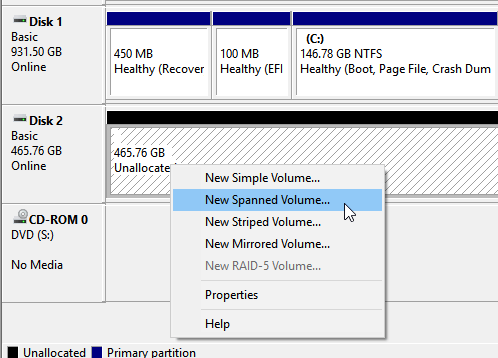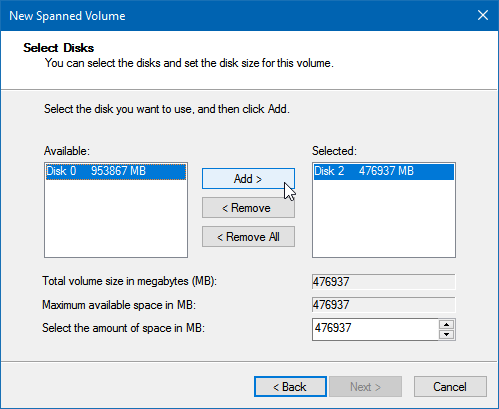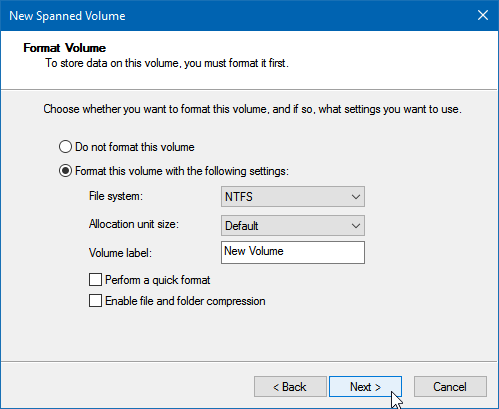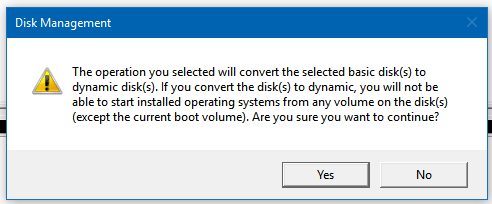In this post, we will show you how to combine multiple Hard Drives into one Hard Drive or Volume on Windows 11/10. You can combine two hard drives and use them as one.
In earlier days, having 512GB of internal storage was more than enough to store documents, music, video, etc. However, now even 2TB of internal storage becomes insufficient for some people, who work as say a video editor and need to save all the source files.

Many movie lovers often collect all the movies they have watched. For them, 2TB is not a huge space to store files. If you are one of them and have installed more than one Hard Drive, here is a simple trick to let you combine two or more hard drives into one on your Windows PC.
What is Spanned Volume and Stripped Volume?
Spanned Volume is used when you want to combine files having different sizes. Stripped Volume can only be used to combine files having the same size. Spanned Volume writes files sequentially which means it will not use the second drive until the first drive is filled. Stripped Volume uses both drives simultaneously, resulting in increased Read-Write speeds.
NOTE: The Virtual Disk Service COM interface is superseded by the Windows Storage Management API, so this will not work on recent versions of Windows like Windows 11 or Windows 10.
How to combine two Hard Drives into one on Windows 11/10
There is no need to use any third-party software for this job as the built-in Disk Management functions well for this purpose.
To get started, make sure you have at least three hard drives installed. The problem with this trick is that you cannot use an installed Operating System from the hard drives. Plus, you cannot install any Operating System on that combined hard drive as well.
To begin, open Disk Management on your computer. To do so, right-click on This PC > select Manage. Therefore, click on Disk Management from left side list. Alternatively, you can press Win +X and select Disk Management from the list.
Here you will find all the Hard Drives installed on your computer. Be very careful, when you are doing this step since you need to delete the whole volume (if any) and create Unallocated space. To do this, right-click on both of the hard drives and select Delete Volume. If your hard drive is new and there is no partition, you can skip this step.
After creating unallocated space, right-click on any of the clean hard drives and select New Spanned Volume or New Stripped Volume – as per your preference.

After clicking the Next button, you should find a window like this-

Here you have to select both the hard drives which you want to combine into. The right-hand side box shows the already selected hard drive. So select the hard drive in the left-hand side box and click the Add button.
By following your screen options, you will see this:

Here you have to select the file system, allocation unit size, volume label or partition name, etc. Make sure you have checked the Perform a quick format box. Otherwise, it will take a lot of time to format your combined hard drive.
Hit Next, and you should get a warning window like this:

It shows a message-
The operation you selected will convert the selected basic disk(s) to dynamic disk(s). If you convert the disk(s) to dynamic, you will not be able to start installed operating systems from any volume on the disk(s) (except the current boot volume).
You have to hit the YES button to proceed and take the operation to its conclusion.
The disadvantage of this trick is that you cannot partition the combined hard drive. Once you use the method, there will be a combined partition of two hard drives.
Can I combine 2 SSD into 1?
Yes, you can use the Windows Disk Management Tool to combine two Solid State Drives into one SSD. It can be a Spanned or a Stripped Volume.